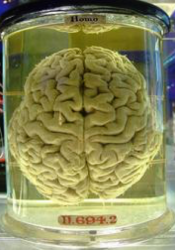Isolation of formaldehyde
After its discovery in 1867 by chemist August Wilhem von Hofman, formaldehyde was isolated for industrial use in 1892 by German chemist Friedrich August Kekule’ von Stradonitz. Immediately after its isolation, chemists unteased its potential as a preservative. Formaldehyde, as well as other modern embalming fluids, works by denaturing proteins throughout the body to prevent bacterial degradation of the tissue. It also acts as an antibiotic making the compound an excellent tool for prolonged dissection. By 1898, over 45 medical schools were implementing formaldehyde into the anatomical studies. The compound laid the foundation for modern dissection, and currently is used in a cocktail of various embalming fluids to enhance body preservation.
Sources:
Brenner, Erich. “Human body preservation – old and new techniques”. Journal of Anatomy. US National Library of Medicine, Jan. 2014. Web. 15 Feb. 2018. Link
Image Source:
Image courtesy of Cornell Biochemistry, retrieved online

